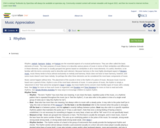
A 34-chapter textbook with lesson plans and activities.
- Subject:
- Career and Technical Education
- Film and Music Production
- Material Type:
- Textbook
- Author:
- Ronda Neugebauer
- Date Added:
- 02/03/2022

A 34-chapter textbook with lesson plans and activities.
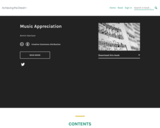
Word Count: 172650
(Note: This resource's metadata has been created automatically by reformatting and/or combining the information that the author initially provided as part of a bulk import process.)

This is an introductory lesson designed for grades 9-12 music appreciation. It will provide a survey of music from other cultures.
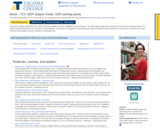
This guide compiles starting points for OER and freely available resources for Music courses and topics. This OER subject guide was created for TCC faculty and staff and reflects TCC credit, continuing education, and corrections course offerings. The purpose of this guide is to help faculty and staff more easily find and review OER in their areas so that they can make decisions about quality, accuracy, relevancy, and potential use.

Word Count: 2217
(Note: This resource's metadata has been created automatically by reformatting and/or combining the information that the author initially provided as part of a bulk import process.)
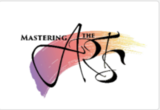
This resource was created by Melissa Smith, in collaboration with Lynn Bowder, as part of ESU2's Mastering the Arts project. This project is a four year initiative focused on integrating arts into the core curriculum through teacher education and experiential learning.
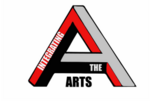
This resource was created by Heidi Meyers, in collaboration with Dawn DeTurk, Hannah Blomstedt, and Julie Albrecht, as part of ESU2's Integrating the Arts project. This project is a four year initiative focused on integrating arts into the core curriculum through teacher education, practice, and coaching.
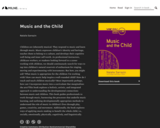
Short Description:
Return to milneopentextbooks.org to download PDF and other versions of this textNewParaChildren are inherently musical. They respond to music and learn through music. Music expresses children’s identity and heritage, teaches them to belong to a culture, and develops their cognitive well-being and inner self worth. As professional instructors, childcare workers, or students looking forward to a career working with children, we should continuously search for ways to tap into children’s natural reservoir of enthusiasm for singing, moving and experimenting with instruments. But how, you might ask? What music is appropriate for the children I’m working with? How can music help inspire a well-rounded child? How do I reach and teach children musically? Most importantly perhaps, how can I incorporate music into a curriculum that marginalizes the arts?NewParaThis book explores a holistic, artistic, and integrated approach to understanding the developmental connections between music and children. This book guides professionals to work through music, harnessing the processes that underlie music learning, and outlining developmentally appropriate methods to understand the role of music in children’s lives through play, games, creativity, and movement. Additionally, the book explores ways of applying music-making to benefit the whole child, i.e., socially, emotionally, physically, cognitively, and linguistically.
Long Description:
Children are inherently musical. They respond to music and learn through music. Music expresses children’s identity and heritage, teaches them to belong to a culture, and develops their cognitive well-being and inner self worth. As professional instructors, childcare workers, or students looking forward to a career working with children, we should continuously search for ways to tap into children’s natural reservoir of enthusiasm for singing, moving and experimenting with instruments. But how, you might ask? What music is appropriate for the children I’m working with? How can music help inspire a well-rounded child? How do I reach and teach children musically? Most importantly perhaps, how can I incorporate music into a curriculum that marginalizes the arts?
This book explores a holistic, artistic, and integrated approach to understanding the developmental connections between music and children. This book guides professionals to work through music, harnessing the processes that underlie music learning, and outlining developmentally appropriate methods to understand the role of music in children’s lives through play, games, creativity, and movement. Additionally, the book explores ways of applying music-making to benefit the whole child, i.e., socially, emotionally, physically, cognitively, and linguistically.
Word Count: 75231
ISBN: 9781942341208
(Note: This resource's metadata has been created automatically by reformatting and/or combining the information that the author initially provided as part of a bulk import process.)

Short Description:
Children are inherently musical. They respond to music and learn through music. Music expresses children’s identity and heritage, teaches them to belong to a culture, and develops their cognitive well-being and inner self worth. As professional instructors, childcare workers, or students looking forward to a career working with children, we should continuously search for ways to tap into children’s natural reservoir of enthusiasm for singing, moving and experimenting with instruments. But how, you might ask? What music is appropriate for the children I’m working with? How can music help inspire a well-rounded child? How do I reach and teach children musically? Most importantly perhaps, how can I incorporate music into a curriculum that marginalizes the arts?
Long Description:
Children are inherently musical. They respond to music and learn through music. Music expresses children’s identity and heritage, teaches them to belong to a culture, and develops their cognitive well-being and inner self worth. As professional instructors, childcare workers, or students looking forward to a career working with children, we should continuously search for ways to tap into children’s natural reservoir of enthusiasm for singing, moving and experimenting with instruments. But how, you might ask? What music is appropriate for the children I’m working with? How can music help inspire a well-rounded child? How do I reach and teach children musically? Most importantly perhaps, how can I incorporate music into a curriculum that marginalizes the arts?
This book explores a holistic, artistic, and integrated approach to understanding the developmental connections between music and children. This book guides professionals to work through music, harnessing the processes that underlie music learning, and outlining developmentally appropriate methods to understand the role of music in children’s lives through play, games, creativity, and movement. Additionally, the book explores ways of applying music-making to benefit the whole child, i.e., socially, emotionally, physically, cognitively, and linguistically.
Word Count: 75231
ISBN: 978-1-998755-32-5
(Note: This resource's metadata has been created automatically by reformatting and/or combining the information that the author initially provided as part of a bulk import process.)
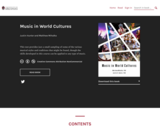
Short Description:
This text provides just a small sampling of some of the various musical styles and traditions that might be found, though the skills developed in this course can be applied to any type of music.
Word Count: 16577
(Note: This resource's metadata has been created automatically by reformatting and/or combining the information that the author initially provided as part of a bulk import process.)
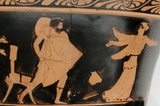
This resource is a lesson plan intended to introduce minoritized freshman and sophomore college students to the study of mythology and to its universal importance as the foundation of our common cultural heritage. The module may also be modified to accomodate high school level language arts courses. This resource will represent approximately three weeks of a typical 10 to 15 week World Literature survey course.

This collection of OER was curated as part of an OER Background Research mini-grant to locate and evaluate resources for a college-level music appreciation course.

Version 2
Short Description:
Open Music Theory is a natively-online open educational resource intended to serve as the primary text and workbook for undergraduate music theory curricula. OMT2 provides not only the material for a complete traditional core undergraduate music theory sequence (fundamentals, diatonic harmony, chromatic harmony, form, 20th-century techniques), but also several other units for instructors who have diversified their curriculum, such as jazz, popular music, counterpoint, and orchestration. This version also introduces a complete workbook of assignments.
Long Description:
Open Music Theory Version 2 (OMT2) is an open educational resource intended to serve as the primary text and workbook for undergraduate music theory curricula. As an open and natively-online resource, OMT2 is substantially different from other commercially-published music theory textbooks, though it still provides the same content that teachers expect from a music theory text.
OMT2 has been designed inclusively. For us, this means broadening our topics beyond the standard harmony and atonal theory topics to include fundamentals, musical form, jazz, pop, and orchestration. And within those traditional sections of harmony and atonal theory, the authors have deliberately chosen composers who represent diverse genders and races. The book is accessible. And perhaps most importantly, the book is completely free and always will be.
The text of the book is augmented with several different media: video lessons, audio, interactive notated scores with playback, and small quizzes are embedded directly into each chapter for easy access.
OMT2 introduces a full workbook to accompany the text. Almost every chapter offers at least one worksheet on that topic. Some chapters, especially in the Fundamentals section, also collect additional assignments that can be found on other websites.
Version 2 of this textbook is collaboratively authored and edited by Mark Gotham, Kyle Gullings, Chelsey Hamm, Bryn Hughes, Brian Jarvis, Megan Lavengood, and John Peterson.
Word Count: 268272
(Note: This resource's metadata has been created automatically by reformatting and/or combining the information that the author initially provided as part of a bulk import process.)

Version 2
Short Description:
Open Music Theory is a natively-online open educational resource intended to serve as the primary text and workbook for undergraduate music theory curricula. OMT2 provides not only the material for a complete traditional core undergraduate music theory sequence (fundamentals, diatonic harmony, chromatic harmony, form, 20th-century techniques), but also several other units for instructors who have diversified their curriculum, such as jazz, popular music, counterpoint, and orchestration. This version also introduces a complete workbook of assignments.
Long Description:
Open Music Theory Version 2 (OMT2) is an open educational resource intended to serve as the primary text and workbook for undergraduate music theory curricula. As an open and natively-online resource, OMT2 is substantially different from other commercially-published music theory textbooks, though it still provides the same content that teachers expect from a music theory text.
OMT2 has been designed inclusively. For us, this means broadening our topics beyond the standard harmony and atonal theory topics to include fundamentals, musical form, jazz, pop, and orchestration. And within those traditional sections of harmony and atonal theory, the authors have deliberately chosen composers who represent diverse genders and races. The book is accessible. And perhaps most importantly, the book is completely free and always will be.
The text of the book is augmented with several different media: video lessons, audio, interactive notated scores with playback, and small quizzes are embedded directly into each chapter for easy access.
OMT2 introduces a full workbook to accompany the text. Almost every chapter offers at least one worksheet on that topic. Some chapters, especially in the Fundamentals section, also collect additional assignments that can be found on other websites.
Version 2 of this textbook is collaboratively authored and edited by Mark Gotham, Kyle Gullings, Chelsey Hamm, Bryn Hughes, Brian Jarvis, Megan Lavengood, and John Peterson.
Word Count: 265669
(Note: This resource's metadata has been created automatically by reformatting and/or combining the information that the author initially provided as part of a bulk import process.)
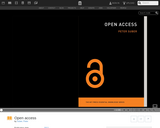
The Internet lets us share perfect copies of our work with a worldwide audience at virtually no cost. We take advantage of this revolutionary opportunity when we make our work “open access”: digital, online, free of charge, and free of most copyright and licensing restrictions. Open access is made possible by the Internet and copyright-holder consent, and many authors, musicians, filmmakers, and other creators who depend on royalties are understandably unwilling to give their consent. But for 350 years, scholars have written peer-reviewed journal articles for impact, not for money, and are free to consent to open access without losing revenue.
In this concise introduction, Peter Suber tells us what open access is and isn’t, how it benefits authors and readers of research, how we pay for it, how it avoids copyright problems, how it has moved from the periphery to the mainstream, and what its future may hold. Distilling a decade of Suber’s influential writing and thinking about open access, this is the indispensable book on the subject for researchers, librarians, administrators, funders, publishers, and policy makers.
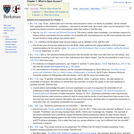
The Internet lets us share perfect copies of our work with a worldwide audience at virtually no cost. We take advantage of this revolutionary opportunity when we make our work “open access”: digital, online, free of charge, and free of most copyright and licensing restrictions. Open access is made possible by the Internet and copyright-holder consent, and many authors, musicians, filmmakers, and other creators who depend on royalties are understandably unwilling to give their consent. But for 350 years, scholars have written peer-reviewed journal articles for impact, not for money, and are free to consent to open access without losing revenue.
In this concise introduction, Peter Suber tells us what open access is and isn’t, how it benefits authors and readers of research, how we pay for it, how it avoids copyright problems, how it has moved from the periphery to the mainstream, and what its future may hold. Distilling a decade of Suber’s influential writing and thinking about open access, this is the indispensable book on the subject for researchers, librarians, administrators, funders, publishers, and policy makers.
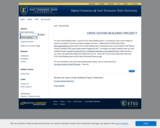
The Open Guitar Building Project—a part of ETSU’s Guitar Building project—is a repository of open source designs for teachers and builders of acoustic and electric stringed instruments. Affiliated with the STEM Guitar Project (http://guitarbuilding.org) since 2010, ETSU’s Guitar Building project is following the open access tradition of this National Science Foundation (NSF) grant-funded student engagement effort. The designs and support materials herein are made available through a Creative Commons BY-SA 4.0 (Attribution-ShareAlike 4.0 International) license; please feel free to use, share, and adapt these designs and materials for your use. All we ask is for you to give appropriate credit to the ETSU Guitar Building project and this Open Educational Resource page.
For more information on the ETSU Guitar Building project, please visit our social media site at http://www.Facebook.com/ETSUGuitars.

Short Description:
This book is an educational, entertaining, and highly personal memoir written during a global pandemic. It provides an insightful snapshot of the occasionally bumpy yet spiritually transformative cancer journey of a middle-aged, immigrant, and non-partnered academic living in a sunny Canadian prairie province.
Long Description:
This book is an educational, entertaining, and highly personal memoir written during a global pandemic. It provides an insightful snapshot of the occasionally bumpy yet spiritually transformative cancer journey of a middle-aged, immigrant, and non-partnered academic living in a sunny Canadian prairie province.
It will be of interest to anyone who: 1) is or has been on the cancer continuum as a patient, caregiver, family member, or friend; 2) is or strives to be a health professional (oncologist, GP, nurse, social worker, pharmacist, physio- or exercise therapist, etc.); 3) is an administrator, instructor, teaching assistant, or student at a post-secondary institution interested in health sciences, English literature (memoir writing, creative non-fiction, and narratives of illness), Women’s and Gender Studies, Spirituality Studies, Religious Studies, and the Fine Arts; 4) fellow authors and/or readers who like to give writers from the Canadian prairies a chance.
The Appendix includes “Leading Reading Questions” meant to increase everyone’s reading experience and lighten the load of fellow university professors who wish to adopt this book, or part of this book, for a class.
Word Count: 53928
ISBN: 978-0-7731-0764-9
(Note: This resource's metadata has been created automatically by reformatting and/or combining the information that the author initially provided as part of a bulk import process.)
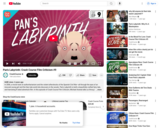
In 2006, a movie took on authoritarianism and the violent aftershocks of the Spanish Civil War—all through the eyes of an innocent young girl and the fairy tale world she discovers in the woods. Pan's Labyrinth is both a beautifully crafted fairy tale, and harrowing R rated adventure film. In this episode of Crash Course Film Criticism, Michael Aranda talks us through Guillermo Del Toro's film, Pan's Labyrinth.
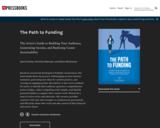
The Artist’s Guide to Building Your Audience, Generating Income, and Realizing Career Sustainability
Short Description:
Based on coursework developed at Peabody Conservatory, this book breaks down the process of developing an artist mission statement, generating new ideas for creative projects, and creating an engaging project description. It also covers methods for artists to identify their audience, generate a comprehensive project budget, collect compelling work samples, and identify potential funders to support their creative work. Written by a team of active artists and educators, this resource provides creatives with tools and strategies to communicate passionately and effectively about their work and take control of their financial and artistic future.
Word Count: 63170
(Note: This resource's metadata has been created automatically by reformatting and/or combining the information that the author initially provided as part of a bulk import process.)